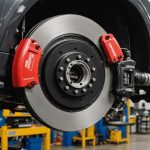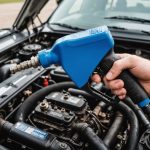In today’s world, ensuring that your vehicle meets emissions regulations is no longer just a matter of compliance, but also of environmental responsibility. As vehicles age, their engines may become less efficient, leading to increased emissions that can harm the air quality. Additionally, various states have enacted stringent standards that require vehicles to pass an emissions test to stay roadworthy. Understanding these regulations and how to manage your vehicle is crucial for both your own peace of mind and the health of the planet. This article will guide you through the essential steps to ensure your vehicle remains compliant with emissions laws, while also outlining the importance of regular maintenance and inspections.
Understanding Emissions Standards
Every vehicle on the road is subject to a set of emissions standards set by the EPA (Environmental Protection Agency) or local regulatory bodies. These standards dictate the maximum allowable levels of pollutants that can be emitted from your vehicle’s engine and exhaust systems. Familiarizing yourselves with these regulations is the first step towards ensuring compliance.
Topic to read : How can you maximize your vehicle’s performance with aftermarket modifications?
The EPA has established baseline standards for different vehicle categories, which include cars, light trucks, and heavy-duty vehicles. These standards vary based on the model year, vehicle type, and fuel type, including gasoline and diesel. Failure to meet these requirements can lead to hefty fines, your vehicle failing the annual inspection, or the necessity for costly repairs.
To understand your vehicle’s specific emissions standards, you can check the owner’s manual or look for a label under the hood. This label usually indicates whether your vehicle complies with federal or state emissions standards. If you are considering purchasing a used vehicle, ensure to verify its compliance status to avoid potential issues down the road.
Also to discover : What should you do if your car overheats while driving on the motorway?
Awareness of your vehicle’s emissions classification is essential. If you live in a region with stricter local regulations, you may be required to adhere to more rigorous standards than those set at the federal level. Additionally, keeping abreast of changes in these regulations can help you anticipate any future adjustments necessary for your vehicle.
Regular Maintenance is Key
The health of your vehicle’s engine significantly impacts its emissions output. Regular maintenance is crucial for keeping your vehicle performing optimally and staying within acceptable emission limits. This maintenance includes routine oil changes, air filter replacements, and regular check-ups of your vehicle’s exhaust system.
An engine that runs efficiently will produce fewer emissions. For instance, changing your oil regularly can help reduce the buildup of harmful substances that might lead to increased emissions. Furthermore, ensuring that your air filter is clean allows for better air intake, leading to more complete combustion of fuel and reduced exhaust emissions.
It’s also important to pay attention to your vehicle’s check engine light. This indicator can signify various issues, including malfunctioning emissions components. Ignoring the light can lead to more severe problems that not only affect your emissions but also your vehicle’s performance and safety.
In addition to regular maintenance, ensure that your fuel system is in good condition. This includes checking fuel injectors for clogs or leaks, as well as ensuring that your fuel type matches the specifications recommended for your vehicle. Using the correct fuel can significantly affect your engine’s efficiency and, consequently, its emissions.
Consider keeping a maintenance log to track your vehicle’s service history, making it easier to identify patterns and potential issues. This proactive approach not only aids in compliance with emissions standards but also prolongs the life of your vehicle.
The Importance of Emissions Testing
Emissions testing is a critical aspect of ensuring that your vehicle meets the required regulations. Most states mandate this testing at regular intervals, typically during annual inspections. Understanding the testing process will help you prepare and potentially avoid failures that can lead to costly repairs.
During an emissions test, your vehicle will be checked to ensure that its engine, exhaust, and fuel systems are functioning correctly and producing minimal emissions. The test typically involves measuring exhaust gases while the vehicle is running and may also include a visual inspection of emission control devices.
If your vehicle fails the emissions test, you will receive a detailed report indicating the specific issues that need addressing. Common reasons for failure include problems with the catalytic converter, oxygen sensors, or other critical components of the emission control system. Addressing these issues quickly is essential to avoid further penalties and ensure your vehicle remains compliant.
You can prepare for the emissions test by ensuring that your vehicle is well-maintained and up-to-date on any necessary repairs. Some mechanics offer pre-test inspections to identify potential problems before the official test, giving you the opportunity to address them proactively.
Additionally, keep in mind that certain modifications to your vehicle, such as aftermarket exhaust systems, can affect emissions output and may lead to a failed test. If you are considering such modifications, ensure they are compliant with local emissions regulations to avoid complications during testing.
Investing in Clean Technologies
As awareness of environmental issues grows, many vehicle manufacturers are investing in clean technologies to reduce emissions. These innovations range from electric vehicles (EVs) to hybrid models, which offer significant advantages in terms of reducing air pollution and conserving fuel.
Switching to an electric vehicle can drastically lower your carbon footprint, as these vehicles produce zero tailpipe emissions. If you aren’t ready to make the leap to electric, consider hybrid vehicles that combine an internal combustion engine with electric propulsion. These hybrids often produce fewer emissions than their gasoline-only counterparts and can provide substantial fuel savings.
Moreover, many manufacturers are developing advanced technologies that improve the efficiency of traditional vehicles. Innovations such as turbocharging, direct fuel injection, and improved exhaust treatment systems can greatly reduce emissions while enhancing engine performance.
Stay informed about the latest advancements in vehicle technologies that promote sustainability. Participating in local workshops or forums can provide valuable insights into the benefits of clean technologies and how they can contribute to better air quality.
In addition to personal vehicle choices, advocating for cleaner transportation options in your community, such as carpool programs or better public transit, can enhance overall air quality and reduce emissions on a broader scale. By supporting initiatives that promote clean technologies, you contribute to the collective effort towards a healthier environment.
Ensuring your vehicle complies with emissions regulations is a multifaceted process that requires diligence, awareness, and proactive maintenance. From understanding emissions standards to regular vehicle upkeep and emissions testing, each step contributes to reducing your vehicle’s impact on the environment. As you continue to engage with emerging clean technologies, remember that every effort counts in improving air quality and fostering a sustainable future.
By taking these steps, you not only ensure that your vehicle remains compliant with emissions regulations but also play a crucial role in safeguarding the environment for future generations. Whether you’re a seasoned car owner or new to vehicle maintenance, embracing these practices will lead to a more efficient and responsible driving experience.











